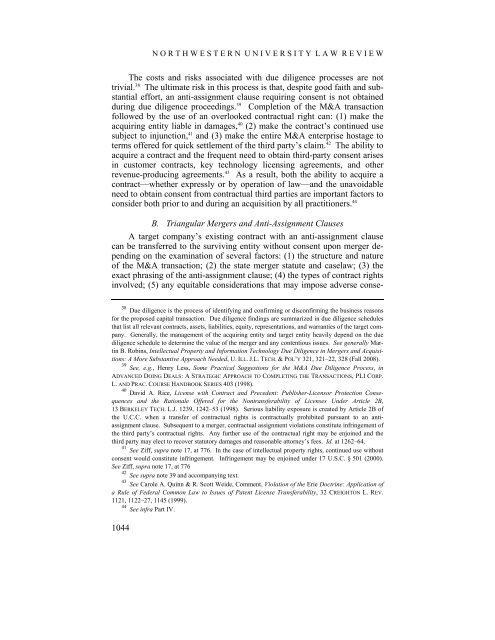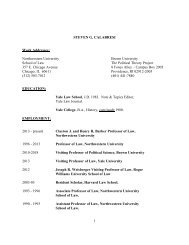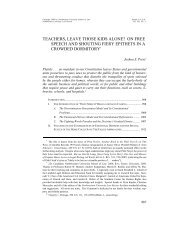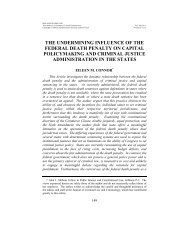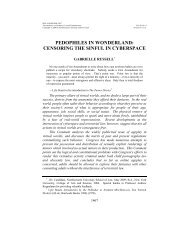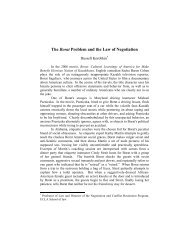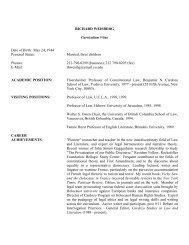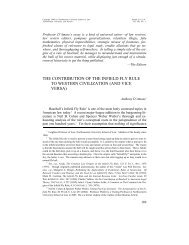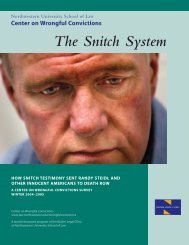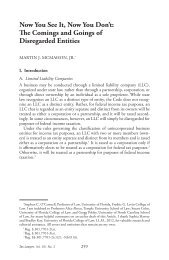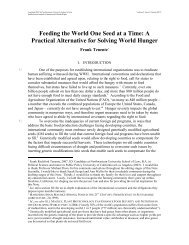The Reverse Triangular Merger Loophole and Enforcing Anti
The Reverse Triangular Merger Loophole and Enforcing Anti
The Reverse Triangular Merger Loophole and Enforcing Anti
You also want an ePaper? Increase the reach of your titles
YUMPU automatically turns print PDFs into web optimized ePapers that Google loves.
1044<br />
N O R T H W E S T E R N U N I V E R S I T Y L A W R E V I E W<br />
<strong>The</strong> costs <strong>and</strong> risks associated with due diligence processes are not<br />
trivial. 38 <strong>The</strong> ultimate risk in this process is that, despite good faith <strong>and</strong> substantial<br />
effort, an anti-assignment clause requiring consent is not obtained<br />
during due diligence proceedings. 39 Completion of the M&A transaction<br />
followed by the use of an overlooked contractual right can: (1) make the<br />
acquiring entity liable in damages, 40 (2) make the contract’s continued use<br />
subject to injunction, 41 <strong>and</strong> (3) make the entire M&A enterprise hostage to<br />
terms offered for quick settlement of the third party’s claim. 42 <strong>The</strong> ability to<br />
acquire a contract <strong>and</strong> the frequent need to obtain third-party consent arises<br />
in customer contracts, key technology licensing agreements, <strong>and</strong> other<br />
revenue-producing agreements. 43 As a result, both the ability to acquire a<br />
contract—whether expressly or by operation of law—<strong>and</strong> the unavoidable<br />
need to obtain consent from contractual third parties are important factors to<br />
consider both prior to <strong>and</strong> during an acquisition by all practitioners. 44<br />
B. <strong>Triangular</strong> <strong>Merger</strong>s <strong>and</strong> <strong>Anti</strong>-Assignment Clauses<br />
A target company’s existing contract with an anti-assignment clause<br />
can be transferred to the surviving entity without consent upon merger depending<br />
on the examination of several factors: (1) the structure <strong>and</strong> nature<br />
of the M&A transaction; (2) the state merger statute <strong>and</strong> caselaw; (3) the<br />
exact phrasing of the anti-assignment clause; (4) the types of contract rights<br />
involved; (5) any equitable considerations that may impose adverse conse-<br />
38 Due diligence is the process of identifying <strong>and</strong> confirming or disconfirming the business reasons<br />
for the proposed capital transaction. Due diligence findings are summarized in due diligence schedules<br />
that list all relevant contracts, assets, liabilities, equity, representations, <strong>and</strong> warranties of the target company.<br />
Generally, the management of the acquiring entity <strong>and</strong> target entity heavily depend on the due<br />
diligence schedule to determine the value of the merger <strong>and</strong> any contentious issues. See generally Martin<br />
B. Robins, Intellectual Property <strong>and</strong> Information Technology Due Diligence in <strong>Merger</strong>s <strong>and</strong> Acquisitions:<br />
A More Substantive Approach Needed, U. ILL. J.L. TECH. & POL’Y 321, 321–22, 328 (Fall 2008).<br />
39 See, e.g., Henry Less, Some Practical Suggestions for the M&A Due Diligence Process, in<br />
ADVANCED DOING DEALS: A STRATEGIC APPROACH TO COMPLETING THE TRANSACTIONS, PLI CORP.<br />
L. AND PRAC. COURSE HANDBOOK SERIES 403 (1998).<br />
40 David A. Rice, License with Contract <strong>and</strong> Precedent: Publisher-Licensor Protection Consequences<br />
<strong>and</strong> the Rationale Offered for the Nontransferability of Licenses Under Article 2B,<br />
13 BERKELEY TECH. L.J. 1239, 1242–53 (1998). Serious liability exposure is created by Article 2B of<br />
the U.C.C. when a transfer of contractual rights is contractually prohibited pursuant to an antiassignment<br />
clause. Subsequent to a merger, contractual assignment violations constitute infringement of<br />
the third party’s contractual rights. Any further use of the contractual right may be enjoined <strong>and</strong> the<br />
third party may elect to recover statutory damages <strong>and</strong> reasonable attorney’s fees. Id. at 1262–64.<br />
41 See Ziff, supra note 17, at 776. In the case of intellectual property rights, continued use without<br />
consent would constitute infringement. Infringement may be enjoined under 17 U.S.C. § 501 (2000).<br />
See Ziff, supra note 17, at 776<br />
42 See supra note 39 <strong>and</strong> accompanying text.<br />
43 See Carole A. Quinn & R. Scott Weide, Comment, Violation of the Erie Doctrine: Application of<br />
a Rule of Federal Common Law to Issues of Patent License Transferability, 32 CREIGHTON L. REV.<br />
1121, 1122–27, 1145 (1999).<br />
44 See infra Part IV.


